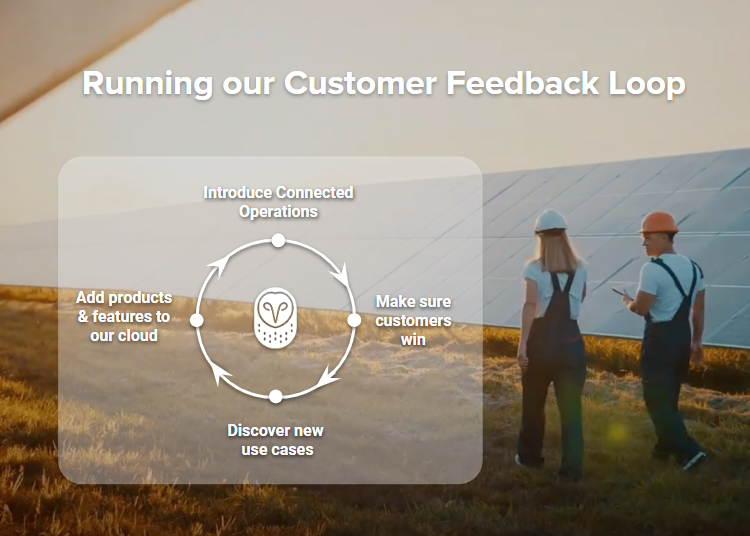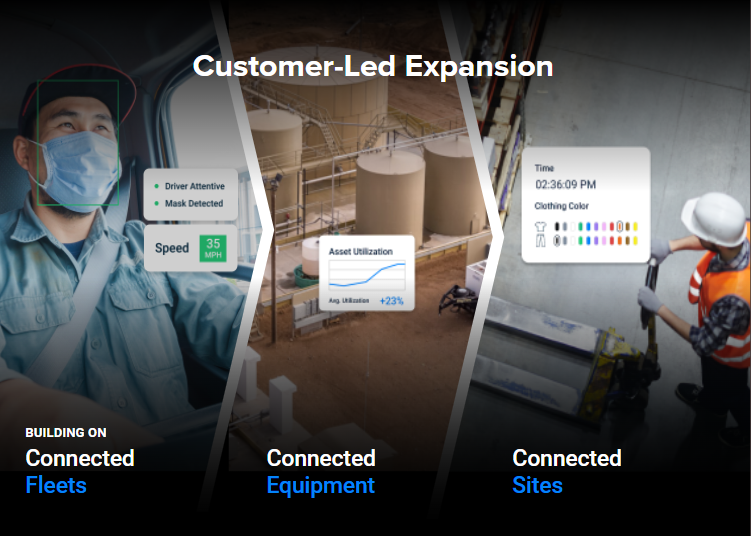What are the key product and organizational learnings from taking a company to $500 million in annual recurring revenue in just six years?
Kiren Sekar joined Samsara’s founding team as CPO after working with the co-founders at their previous company, Meraki. Applying the lessons from Meraki, Kiren will share how Samsara broke into the under-served world of physical operations, the importance of customer feedback, a multi-product strategy, and why culture matters.
Lean on customer feedback loops to guide through unfamiliar markets
At Meraki, they gained feedback from customers intuitively. But at Samsara, the customer feedback strategy became a directive, an important guiding function of company and product growth.
“A culture of customer feedback became one of the most crucial principles for building the company. We sat down with customers and genuinely asked what problems they had and where we could address them.”
One example is from the earliest days of product development. They visited Cowgirl Creamery, a popular cheese manufacturing company in California’s Bay Area. Initially, they had planned on using their temperature sensors to get readings on refrigerators at the company’s main buildings.
However, the initial tests didn’t get very far. The staff was helpful, and generous with their time, but they eventually pointed out that the coolers didn’t often fail, so Samsara was solving for a non-issue. The company’s executives then asked if Sekar could help with temperature monitoring for their fleet of trucks, which was more of a pain point. This ask redirected the entire product focus from an execution standpoint. The feedback prompted them to begin work on what became their offering for trucking fleets.
Listen to your customers and get feedback early and often from them. They often understand the markets you are looking to address better than you do. You’d be surprised how frequently these conversations steer your product and services in significant and innovative ways.
Get creative about gathering feedback
How else can you get valuable product insights from your customers, aside from actually visiting them on-site as much as possible? Here are a couple of ideas.
- Provide a direct feedback feature. Samsara’s tools allow customers to provide feedback directly to the company, allowing customers to be proactive in communicating their thoughts about the product. Enabling this tool can empower customers to feel more connected and take action into their own hands while providing a stream of data to the company.
- Capture product feedback through sales and marketing conversations. Use Salesforce to log product complaints, requests, and more. You can start to monitor patterns of which specific verticals are asking for different features so that the most highly requested items can become roadmap priorities. This also encourages employees not on the product team to take ownership in product development.
Samsara’s customer feedback loop went something like this:
- Discover new use cases
- Add products and features
- Introduce connected operations
- Make sure customers win
This loop is repeatable for other businesses to modify but use in similar ways.
By harnessing these tools for capturing customer feedback, you and your team can get a good read into what decisions are needed at an organizational level.
A little hardware can unlock massive software
This learning became clear for Samsara as they launched physical products in fleet tracking, temperature regulation, and video safety.
“We are primarily a software company, but by introducing hardware into our product suite, our customers have more offerings from Samsara.”
By launching physical products, your organization can easily relate to your customers with devices that they have a better understanding of. They’ll know how these devices can affect their business. In turn, the software readings can provide them with actionable insights that lead them to make operational changes.
Take the example of the customer feedback button from above. This type of software integration would not have been possible without hardware in the field to provide the ease of capturing that data. Other examples are sure to follow.
Multi-product, as early as possible
It’s important to hone in on one product offering and nail it. Get good at that one thing your customers want and need. But don’t cut yourself off from the possibility of other product innovations just because of one product’s success.
“As a CPO, I have to be disciplined about working on new products, even when it feels unnatural or premature to do so.”
Samsara started to work on their second product in video safety when their first product was growing quickly. This decision was not an easy one to make, as it would have been more simple to double down on investment in the first product that was already a booming success.
By being open to new product avenues, Sekar helped lead Samsara into new revenue streams. As a result, the company now offers two distinct products with over $200 million in annual recurring revenue each. They likely would not have gotten to $500 million in ARR as quickly by sticking to the first successful product.
Industry transformation takes decades – think long term
As a day-to-day operator, one of the hardest things to do is zoom out and see the long-term organizational picture. You are focused on short-term execution and hence, it can be difficult to keep the longer-term goals in mind.
“When thinking short term, it can be hard to notice longer-term trends going on. When you zoom out and see the larger forces at play, industry transformation can be dramatic.”
Here’s an interesting case study that crystallizes this point. Before starting Samsara, Sekar worked with the same founding team at Meraki, which focused on wireless device connectivity. 30 years ago, in 1991, there were only about 10,000 wireless devices in use, and these mostly came from the cash register industry. By 2001, when laptops started to surf the web, about 1 million devices existed. In 2011, when Meraki started to experience very high growth, around 100 million devices were in use, thanks to smart devices like phones and tablets.
Still, in the day-to-day execution, he worried that they’d run out of addressable market share. Now, there are 10 billion WiFi clients in circulation, even for something as simple as a garage door opener. This trend shows no sign of slowing down, yet it was hard to see it coming at the moment.
As an operator at Meraki, it was hard for Sekar to fully register this transformation. But being able to zoom out, the transformation is dramatic. Make sure to build time for those bigger picture reflections and conversations, even while being deep in the weeds of short-term execution.
Key takeaways
These learnings offer practical, high-level advice for scaling a company while achieving both product and revenue growth.
- Carve time out to listen to your customers. Serve them and make their feedback important for guiding your product development. Be systematic and disciplined about making this part of your process.
- Get creative about how you receive feedback and incorporate it into your plans.
- The physical offerings of hardware products can provide a range of software benefits.
- Don’t let one product’s success keep you from taking chances on other product streams when the opportunity is right. Run product feedback loops across all areas.
- Zoom out from the most immediate tasks at hand. Don’t lose sight of your long-term product goals amid short-term execution.
The more you incorporate these guiding principles, the more likely you will be to achieve your ultimate goals, both in execution and in revenue.



